Mondi Aligns Sustainable Paper and Packaging Strategy with SDGs
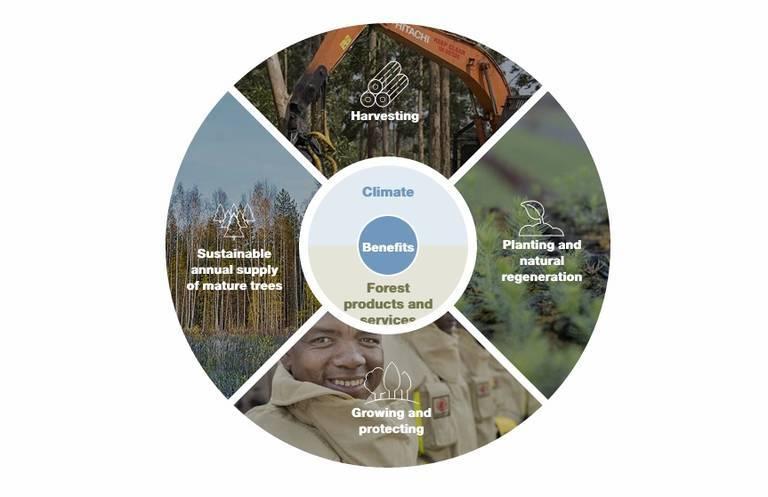

Mondi, the Vienna-based international packaging and paper group, has invested an impressive €41.7m ($51.2m, £36.4m) in community projects during the past five years. Of this, €9.6m was contributed last year.
The company, which has 24,400 employees at 102 centers in more than 30 countries, proudly records the figures in its annual report just published.
Mondi’s aims and attainments, listed in the report as evidence of its strong links with the UN Sustainable Development Goals, range from employee and contractor safety through climate change measures to creating value for customers.
In Partnering for Change, the sustainability part of its 2017 reporting, the company assesses how it is using its model known as Growing Responsibly to achieve significant improvements in the aspects of sustainability that are most relevant to its business and its stakeholders.
Altogether 829,900 hours were reported to have been covered by training of employees and contractors during the year, 37 per cent of that time dedicated to safety and health.
Another aspect of the company’s policy on its workforce is emphasized in its stance on gender. Its overall workforce is now 22 per cent female, and 25 per cent of its board members are women.
On materials, Mondi says 65 per cent of the fuel for its mills comes from renewable biomass-based sources, and 71 per cent of wood procured is certified by the Forest Stewardship Council or the Program for the Endorsement of Forest Certification.
On waste, 18 per cent less of the company’s specific refuse has ended up in landfill since 2015.
On environmental protection, Mondi says 25 per cent of the forest land in its ownership is set aside for conservation.
Peter Oswald, the group chief executive, reflects: “As we further embed sustainability into our global operations and ensure delivery against our long-term strategic business objectives, transparent and collaborative relationships and partnerships remain key, both across our business and beyond.”
Illustration: Mondi
Clean Water for All Starts with Technology


By Erin Connor
Water is everywhere. It covers 70% of our planet and makes up nearly 60% of the human body. Despite its abundance, 663 million people around the world lack access to safe water.
Another 2.4 billion people lack access to a toilet or latrine, while more than 3.5 million people die each year because of inadequate water supply, sanitation, or hygiene. The earth may be covered in water, but only 3% of that is fresh water, and only a small fraction of that is available to the planet’s 7.5 billion inhabitants.
In many communities in developing countries, the lack of access is compounded by a number of challenges, including poor sanitation, lack of awareness of hygiene practices and water treatment technologies, and limited local capacity to manage, maintain, and repair water points.
Lack of access to clean water and sanitation results in economic losses of $260 billion each year and poor communities are impacted most acutely. The burden of water collection falls primarily on women and children, who spend 125 million hours each day collecting water, often walking long distances to do so. This is time and energy that could be better spent in school, pursuing careers, or supporting their families.
The impact of a dollar and a drop
Water is tied to every aspect of our lives. Clean water and sanitation is a critical part of the United Nations’ Sustainable Development agenda, and it’s uniquely tied to all 17 of its overarching goals. It drives economic growth, supports food and energy production, and is key to biodiversity, health, and social development.
It’s no wonder that for every US$1 invested in water, sanitation, and hygiene (WASH), we see a US$4.30 return. Access to safe water means fewer illnesses, reduced health care costs, improved school attendance, and longer, more productive lives.
Tapping into the power of digital solutions
At Cisco, we recognize the need for sustainable access to safe water and the tremendous impact of ensuring access to clean water on all aspects of society. It’s why we’ve awarded over 21 grants to nine different nonprofit grantees since 2010, reaching more than 3900 organizations and nearly 50 million people.
By investing in digital solutions, we are helping nonprofit organizations to increase the efficiency and quality of their programs, reduce overall costs, and enable greater reach and scale of WASH initiatives around the world.
Akvo Foundation, for example, creates open-source, mobile software and sensors to help partners improve the management of water and sanitation. Today, their mobile-based data collection tool, Akvo FLOW, is used by over 250 organizations in over 40 countries, enhancing the ability of governments, nonprofits, and communities to plan, implement, and remotely manage WASH projects. Their new tool, Akvo Lumen, helps organizations aggregate, map, and analyze their data for greater insights and actionable information.
Portland State University and Sweet Sense, its social enterprise spin-off, have developed low-cost, remote sensors to improve the reliability and sustainability of water service delivery. Their sensors can alert local maintenance workers via SMS when a water point breaks down, reducing response time and downtime of water points, thus improving access and the reliability of water sources.
Technology can also help bridge the vast human resource capacity gap in the WASH sector. A recent study in just 10 countries found that in order to reach Sustainable Development Goal 6 of access to safe water and sanitation for all, more than 787,000 trained WASH professionals are needed.
The Centre for Affordable Water and Sanitation Technology (CAWST) provides online resources and virtual training to local organizations, to build their capacity in meeting their communities’ needs for water, sanitation, and hygiene. CAWST’s Virtual Water Expertise and Training (WET) Centres use internet-based solutions — such as e-training modules, online information resources, webinars and video-based training — to expand the reach of CAWST’s services to more than 3000 organizations in 164 countries.
We know the Sustainable Development Goals are bold, ambitious targets. We also know that technology can play a critical role in achieving these goals.
Organizations such as Akvo Foundation, Sweet Sense, and CAWST demonstrate the impact that technology can have in addressing water and sanitation challenges, and in helping realize SDG 6: to ensure availability and sustainable management of water and sanitation for all.
Access to clean and safe water is a human right, one we believe in and continue to support. On World Water Day, we recognize the governments, fellow companies, nonprofit organizations, and communities around the world working to achieve universal coverage for all.
Visit csr.cisco.com to learn more about Cisco’s support for nonprofits and technology-based solutions.
Photo: Cisco
Originally published on 3BL Media.
Erin Connor is Cisco Corporate Affairs & Cisco Foundation
Measuring Natural Capital – Briefing


Companies appreciate that natural capital greatly benefits business, but what is required is quantifying and demonstrating the business value of natural capital.
In Ethical Corporation’s latest briefing, you will learn key strategies for your company to ensure the natural capital measurement is achieved and taken to the heart of decision-making.
Click here to see your complimentary copy of the briefing
With expert insights from:
- Michaël Beutler, Director of Sustainability Operations, Kering
- Hannah Pitts, Relationships Director, The Natural Capital Coalition
- Andy Griffiths, Head of Environmental Sustainability, Nestlé UK and Ireland
- Peter White, Chief Operating Officer, WBCSD
- Emma Ringström, Sustainability Manager, AkzoNobel
- Mark Reed, Professor of Socio-Technical Innovation, Newcastle University
- Jessica Fries, Executive Chairman, Accounting for Sustainability
Click here to see your complimentary copy of the briefing
Media Contact:
Candy Telani Anton
Head of Europe
+44 207 375 7162
Renewable Hydrogen Emerging As Decarbonization Option For Business

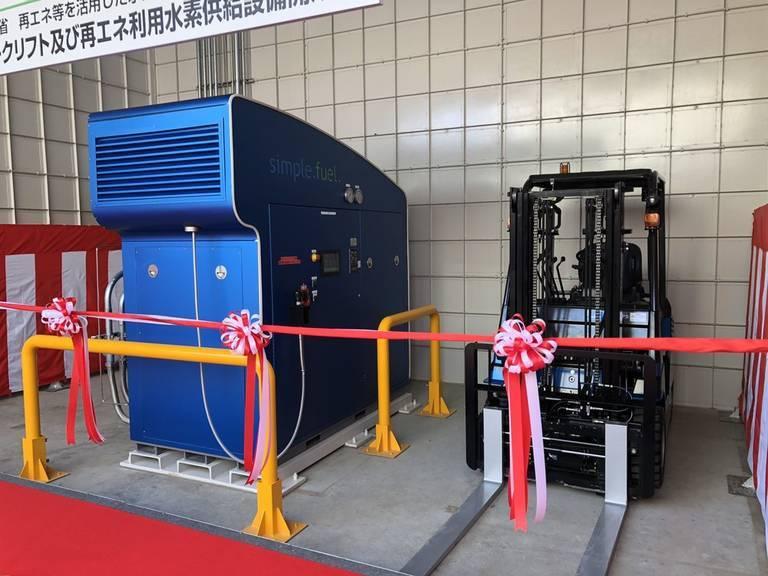
Corporate buyers have stepped in to keep the renewable energy transition moving along at a rapid clip here in the US. So far the interest hasn't strayed too far from wind turbines and solar panels, but two new developments suggest that a third option -- hydrogen -- could soon be in the running when businesses consider their clean power options.
Why hydrogen?
Hydrogen still gets short shrift as a pathway to decarbonization, and for good reason. Though hydrogen is a zero emission fuel, the natural gas angle loads it up with a pile of environmental baggage.
The impacts of fossil natural gas are well known all up and down the supply chain, but it's worth a quick review of the main problems:
Local air and water pollution issues linked to natural gas drilling.
Earthquakes and other local impacts linked to the disposal of drilling waste.
Climate change impacts linked to methane emissions from drilling, transportation and storage sites.
Fortunately, the emergence of low cost wind and solar energy has provided a low emission pathway for producing natural gas, by "splitting" water through a chemical reaction touched off by an electrical current.
Water-splitting has been around for a long time (water is partly hydrogen, as you may remember from science class), but it requires energy. Up until recently, that was an expensive, carbon intensive deal breaker.
A knowledge base for water-splitting with renewable energy has been building, so the biggest obstacle now is bringing the cost down to where it makes sense commercially.
As for why go through all that trouble to make hydrogen, well, it is an abundant, zero emission fuel that can be produced domestically in large quantities.
Hydrogen fuel cells can be refueled in a few minutes, like a gas tank. Though hydrogen vehicles have been slow to catch on for personal mobility, the quickness factor has won over fans in logistics and other commercial sectors that run on a tight clock.
To ice the cake, hydrogen acts as a storage and transportation system for wind and solar energy.
So, where's the hydrogen?
Renewable hydrogen fuel is not ubiquitous now, and that's partly because of the catalyst that drives the chemical reaction in water-splitting. You need the right balance between high efficiency and low cost, which means that conventional catalysts just won't do.
That's where the first of our two latest developments comes in. The company HyperSolar just announced an update on its new wireless, fully integrated solar water-splitting system, called GEN 1. The company is banking on GEN 1 to be its first commercial solar powered water-splitting device.
They've already taken care of the solar chore, which will be shouldered by off-the-shelf high efficiency solar cells. The challenge for HyperSolar is to get their proprietary catalyst to operate efficiently in alkaline conditions.
The company reports that in earlier iterations, the catalyst was one of the least stable components of the system. The latest round of tweaking was a significant improvement: the catalyst exceeded 870 hours of operation while the entire device suffered degradation only after 105+ hours.
That's still a far cry from the 1,000 hours of operation that HyperSolar estimates is needed to push the technology into commercialization, but the improvement enabled the team to pinpoint the source of the problem and identify a pathway for fixing it.
Somebody is not waiting around for that perfect catalyst!
By the time HyperSolar has fine-tuned its catalyst, the company should have plenty of takers. Corporate buyers may lean on fossil-sourced hydrogen for now, but they are in position to jump on the early opportunities to shift to renewable hydrogen.
The hydrogen economy is already sparking interest in the business world, including major players like Amazon, UPS and the startup Nikola.
Hydrogen policies in the EU as well as the UK, the US and Japan are also helping to push the trend. That leads us to the second major news item this week.
In a demonstration that the renewable hydrogen economy is rapidly globalizing, US technology will have its first real-world trial run in Japan.
A consortium of companies has deployed its first compact, low cost hydrogen refueling station in Japan. The group includes US-based Ivys Energy Solutions and PDC Machines, with Japanese partner Tokyo Boeki Mechanics
Called SimpleFuel, the bright blue refueling station has received funding from the US Department of Energy, so group hug for taxpayers!
Here's the rundown:
The SimpleFuel® appliance, paired with a hydrogen-fueled fork lift truck from Toyota Industries, officially began operation today with a ribbon-cutting ceremony at the Kesen Precut Cooperative, a tree and timber production co-op in Iwate Prefecture, Japan.
With support from the Japanese Environmental Ministry of the Central Government, the SimpleFuel® appliance at Kesen will use solar or grid electricity to produce and deliver hydrogen for use with a Toyota Industries fuel-cell forklift truck.
That's just for starters. The partners already announced that SimpleFuel is coming to the US, Europe and other parts of Asia.
If you caught that thing about "or grid electricity," that's a signal that the renewable hydrogen economy still has a way to go -- but it's getting there.
Photo: via Ivy Systems.
Bird Estuaries and Boardwalks: Quantifying the Costs of Sea Level Rise


Global warming is a major concern for communities along California’s sweeping Pacific coastline. More than 600 miles of western shoreline stretches between the state’s north and south boundaries, pocketed by old-growth forests, carefully preserved beaches and small, historic towns that serve as magnets in California’s thriving tourism industry. The world’s sixth largest economy realized more than $125 billion from tourism in 2016 alone, driven in part by the throngs of tourists that head each year to landmarks like Disneyland in the south and San Francisco’s historic Pier 39 two-thirds of the way up the coast.
No region however, is a more iconic symbol of California’s carefully sheltered tourism industry than Santa Cruz County. Situated barely 90 minutes south of San Francisco and framed on the west by a curve of towering cliffs and dotted by sandy beaches, the county is proof of the fact that small localities can and do have a big economic punch. As the state’s second-smallest county, Santa Cruz reaped $700 million in tourism revenue in 2000 and recorded one million visitors. Its 29 miles of beaches and historic boardwalk were a large part of the county’s draw.
But according to a report published by the Central Coast Wetlands Group at the Moss Landing Marine Labs, those vital resources will be at increasing risk in the decades to come. Sea level rise and climate change will have a greater say not only in how its coastline is affected by storms but in how the county manages its valuable resources.
Increasing storm surge, say the authors of the Santa Cruz Coastal Climate Vulnerability Report, doesn’t just mean that central California beaches will be harder to access, but delicate estuaries, which are key to the county’s agricultural and tourism industries, will be at a higher risk of flooding and degradation.
Cities will also face growing challenges. By 2030, barely a decade from now, more than 800 structures are expected to be at risk from flooding as sea level changes continue to define the county’s urban areas.
Reassessing resiliency in Santa Cruz County
Understanding Santa Cruz’s future weather impacts wasn’t the sole reason for the 115-page report, which looked at virtually every section of the 446 square-mile county. According to Ross Clark, director of the Central Coast Wetlands Group, there was a bigger goal at play: To determine just what it would take to ensure resiliency in a county facing increased storm surge and sea level rise – and just what it would cost to do so.
“The intent of this report was not to provide a doomsday scenario, but to provide an evaluation of what the hazard maps really mean and what are the forces that we will be responding to looking forward so that we can make smart decisions on how to invest our limited resources to adapt,” said Clark, who served as the city of Santa Cruz’s climate change coordinator at the time the report was written.
To get an accurate picture of those impacts, researchers from Environmental Science Associates (ESA) and Revell Coastal as well as a broad consortium of environmental, science, geological and local organizations fanned out across the county. They compiled data and constructed models to show the potential impacts. Then they got to work to determine just what it would take to safeguard Santa Cruz, its natural resources and its urban centers.
The process would be complex – and expensive, said Clark, who pointed out that increasing climate impacts wouldn’t just mean coastal infrastructure like sea walls and other barriers would have to be replaced or upgrade more often, but the way homes were built along Santa Cruz’s prime coastal real estate would likely have to adapt to the climate risks as well.
Houses would have to be built with storm surge in mind. “In short, [they] would have to be taller,” said Clark. Building codes would likely change.
“New designs look at putting most of the electric infrastructure higher in the buildings than as is often [currently] the case in the basement or garage.”
Municipalities will be forced to invest in protections against sea level change and a more robust surf.
In all, said Clark, the cost of bolstering the county’s 10-mile stretch of coastal armoring, reinforcing or replacing roads, railways, streets, culverts and other infrastructure, will be significant. In the next 12 years alone, climate change impacts are expected to cost the county the better part of a half a billion dollars. The cost to private homeowners whose properties lie in the path of these impacts, however, will be much greater: about $1.2 billion.
But the impacts that Santa Cruz and its municipalities face poses another problem: adding reinforcements to protect homes and businesses may mean sandy beaches wash away. And tourists and their vacation budgets will head to other destinations too.
“[We] documented that we would lose significant portions of sandy beaches in the Monterey Bay portion of Santa Cruz County by 2100 if we protect everything in place. Much of the Santa Cruz coastline will transition from beach to breaking waves along the coastline. That has economic ramifications that really haven’t been fully understood. But business owners can understand individually what the loss of tourism and the loss of Santa Cruz as a beach destination would mean,” Clark said.
Assessing the costs: Who pays? But there’s another issue that ties into Santa Cruz’s climate woes: one that the report didn’t address directly, but has gained increasing attention in California district courts in recent years: Who is responsible for the county’s infrastructure damages and who ultimately should pay for those impacts?
Since 2008, more than seven U.S. communities have launched lawsuits against oil and gas companies, alleging that the high carbon emissions are responsible for the degradation of coastlines and local habitat. The allegations aren’t based on local extrapolations, but on data that ExxonMobil investigated in the 1980s and has been corroborated by scientific studies since that time.
But as communities like Kivalina, Alaska found out, proving that fossil fuel companies are responsible for worsening climate change takes more than data in U.S. courts. The small indigenous community, which is losing its land to sea level changes and storm surf, launched its “nuisance” claim against a group of energy producers in 2008, when third-party global warming research was still in its early stages. Both Kivalina’s complaint in the U.S District Court for the Northern District of California and its subsequent appeal in 2012 were denied.
Since that time, a growing number of California communities have filed suits, including San Francisco and Oakland. Their attempts to pinpoint the responsibility of global warming on oil and gas companies has rested on new research into the cause and origins of global warming, the legitimacy of which was strengthened by the Obama administration’s efforts to limit greenhouse gases in recent years.
But the strategies have also changed. In 2017, Santa Cruz County and its capital city, Santa Cruz, launched separate suits against 29 oil and gas companies. Like San Francisco and Oakland, they asserted that private and public landowners have rights that are abridged when properties are trespassed and damaged by conditions that could have been prevented by a third party’s business decisions.
While Santa Cruz County would not comment on the progress of the suit, Jason Hoppin, the county’s communication manager, did acknowledge that the county and its capital city aren’t alone in their efforts to deal with climate change – or to pressure high carbon emitters like oil and gas extraction companies to take responsibility and change the way they do business.
“Santa Cruz County has unique vulnerabilities to the impacts of climate change, but climate change can potentially impact every community,” said Hoppin. “There is an environmental reckoning taking place across the globe, and it is incumbent upon leaders in every community to do what they can to look into the future and see what measures may be needed to protect the life and property of their citizens.
“It’s time to hold the oil and gas companies responsible for their role in climate change. Local residents shouldn’t be only one’s paying for the damage caused by their products,” added Hoppin.
These days there’s also a wider effort by communities to share and collaborate on ways to deal with climate change. According to Clark, several county and nonprofit programs have emerged in recent years to help cities brainstorm and seek feedback on topics like mitigation, adaptation and fiscal challenges. That collaboration is helping to ensure their communities’ future resiliency.
“Managing the California coast can’t be done as individual towns and cities,” said Clark. “It really has to be done as a partnership [with] everyone up and down the coast.”
This article was originally published in CR Magazine
Hilton Takes the Lead on Treating Service Workers with Dignity


Much has been made about how companies across many industries are going out of their way to attract who they view as the best and the brightest employees. But in comparison, service workers, particularly those who work in retail, food service and the travel sector, have long been given the shaft.
But there is a slow, yet noticeable shift, as more companies understand that corporate responsibility also applies to how your workers on the front lines are treated. And in the midst of what most economists agree is a tight labor market, businesses really have no choice – employees who are dissatisfied with how they are treated can voice their displeasure by submitting their two-week notice and speaking with their feet as they walk to another job opportunity.
One company that has made a huge shift in the amenities that it offers to its service employees who work in areas such as food service, housekeeping and customer service is Hilton Hotels. As Oliver Staley recently showcased on Quartz, to start, the dingy breakrooms similar to the ones that anyone of us who has worked in hotels, department stores or casual restaurants are becoming revamped.
For now, the number of such hotels number in the hundreds. Hilton’s goal is to make sure that number reaches the thousands – no easy task as the company, as is the case with many hotel chains, does not actually own their properties, but instead franchises them to what are usually real estate investment trusts.
As Staley’s article points out, however, the results have largely been positive, as service workers have responded to brightly painted, decorated and well-lit breakrooms and cafeterias. Other benefits granted to salaried workers, such as the privilege to carry their cell phones, investment in more comfortable uniforms - and even generous discounted room plans - also help reduce turnover while further engaging employees.
The commitment to improved day-to-day experience for service workers is another tool in Hilton’s kit as it continues to build a reputation as a responsible hospitality company. The company claims an inclusive culture, from its reputation to within the LGBT community, to its claim that it hired 10,000 veterans over the course of three years. Local community service programs and even a soap recycling program are included in the company’s corporate responsibility agenda.
Other companies insist they are doing more to bridge the benefits gap between salaried and hourly employees. Starbucks, which last year was accused of having an unfair maternity leave policy, earlier this year rolled out a more generous maternity and parental leave program for all employees. The coffee giant also claims it has achieved gender pay equity for all white-collar and “partners” who work at its retail outlets. And in the retail sector, competitors Target and Walmart are realizing that higher wages are necessary in order to reduce costly labor turnover – but are still far behind Costco when it comes to workers’ pay, benefits and job satisfaction.
Image credit: Hilton Hotels/Facebook
Applications Now Open for 2nd Annual Conscious Company Leaders Forum
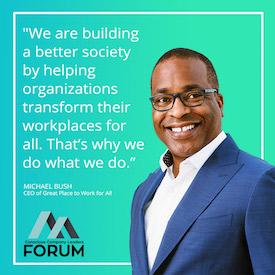
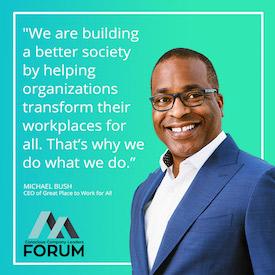
Invite-only event for CEOs and VPs in conscious business announces initial speaker line up
“The Leaders Forum was the most valuable event that I attended last year.” —2017 Forum attendee
Conscious Company Media’s Leaders Forum has become the premier gathering for the who’s who of CEOs, executives, investors, and thought leaders who are interested in conscious business, where companies make a profit and have a positive impact on society.
For three days from June 6–8, 2018, a curated group of business leaders from some of the most impressive brands in the space gather at a world-class mindfulness retreat center in the heart of the redwood forest to have real, unfiltered conversations about what’s really working for conscious leaders and businesses. If you feel you should be in this room, please apply today to reserve your spot and get the best ticket price.
Attendees Will:
- Listen to the real, unfiltered stories from behind the scenes of some of the most innovative brands in the space
- Establish one-on-one connections with fellow leaders in a relaxing, rejuvenating environment
- Learn how to be a more effective leader, how to create a more engaged workplace, and how to have a greater impact on the world through your business
- Connect deeply with some of the most successful people in conscious business who are representative of the movement’s diversity across age, sex, race, and industry
- Participate in deep-dive workshops hosted by world-class facilitators and trainers
- Enjoy time for yoga, hiking, fresh meals, and holistic well-being
Speakers Include:
- Michael C. Bush: CEO at Great Place To Work®
- Lorna Davis: Global Ambassador, B Lab; former CEO, DanoneWave
- Mark Rampolla: CEO, Beanfields Snacks; Managing Partner, Powerplant Ventures; Founder and former CEO of ZICO Beverages
- Rodney Foxworthy: Executive Director, BALLE
- Deepa Purushothaman, National Managing Principal, Inclusion at Deloitte
- Chad Houser: Founder and Executive Director, Café Momentum & 2018 CNN Hero
- And many more…
Who will attend?
The Leaders Forum is designed to bring together key executives, decision makers, and business leaders who can have real conversations about what matters most in conscious business. In order to facilitate a transformative experience, Conscious Company curates the attendees on an application-only basis to ensure that every single person in the room is able to engage with and contribute to high-level, nuanced conversations about business and build an incredible conference experience together. The 2017 Forum had over 1,000 people apply for 200 spots and completely sold out. Conscious Company has increased capacity for this year’s event to 300, and expects to sell out quickly.
Why Is This Different?
The Forum is an unparalleled experience where we have deep, raw conversations as business leaders for multiple days. There are no keynotes. No slides. No listening to someone talk at you for hours on end. No, the Leaders Forum is a space where business leaders come to connect, collaborate, and truly engage with each other. Everyone in the audience will be a peer who you can learn something from, not someone who will be pitching you on their product or service. And we require our speakers to drop the façade and talk about what it’s actually like to be a business leader, so we can learn from each other’s mistakes, challenges, and triumphs rather than hear canned, polished speeches. In short, it’s the one event where business leaders come to truly be themselves and find others who they can learn from on their journeys.
More information on speakers, content, and agenda can be found at: ConsciousCompanyLeadersForum.com
For members of the 3BL audience who are accepted to the Forum, please use the code CCLF_3BL for a full 30% discount on your ticket.
Media Contact Info:
Leaders Forum Media Team
[email protected]
FLIR Technology: 'New' Technology Shines a Camera on Greenhouse Gas Emissions


Seeing is often believing when it comes to addressing the impacts of climate change. As the effects of global warming become more noticeable, scientists tell us, public opinion has been shifting toward the importance of addressing climate change. While graphs and statistics make for good discussions, it’s often the “eyeball impact” that drives home the point that the earth’s atmosphere is being altered by the amount of carbon emissions we release.
“The vision of a huge chunk of ice falling off of a massive glacier has more emotional resonance than a spreadsheet full of yearly average of Arctic sea ice extent numbers does, even if the two are saying the same thing,” explains John Cabrer, senior systems design engineer for MoviTherm, a Southern California company that specializes in advanced thermography solutions for businesses. In recent years researchers have found that using that technology in new ways can also help us “see” the hidden environmental impacts of today’s industries.
To advance that effort, Cool Effect, a crowdfunding platform designed to reduce carbon pollution, recently utilized advanced technology to bring a global issue into new perspective with its newest campaign: “Carbon Can’t Hide”. The goal is to help people understand the volume of CO2 discharges we are actually releasing into the atmosphere on a daily basis, and its relationship to the environmental problems the world is experiencing.
Their tool is a uniquely-named device that has been around for years and now plays a key role in a variety of business inspection services. The Forward-Looking Infrared camera, or FLIR for short, was first used by the U.S. military to follow infrared heat signatures. Today it fills a niche in a wide variety of industrial specialties ranging from breast cancer detection to pharmaceutical production and monitoring systems for bird flu.
But in recent years scientists have realized it has another compelling use. Fitted with a special filter, it can help us see carbon emissions. Even those we haven’t got a clue are there.
“What the camera ‘sees’ when it shows a CO2 emission, is actually a drop in temperature of whatever is in the background where the gas is present,” said Cabrer. Most of the time we can’t see the discharge that occurs from a jet plane’s engine as it’s taking off or landing. But the FLIR camera’s technology can isolate those emissions and make them visible.
“On a very simple level, we’ve used what’s called a band pass filter to highlight the presence of the CO2 within these existing heat signatures,” said Cabrer, who pointed out that the CO2 is actually mingling with the heat source, and that allows us to see the CO2. “As a result, images will appear [on film as] brighter and darker in otherwise homogeneous areas when CO2 is present in various concentrations.”
Cabrer notes that FLIR technology gives us “an excellent visual representation of an otherwise invisible substance,” but it doesn’t necessarily help us measure the result. “It is by no means a way of providing scientific measurements of CO2 concentrations present in a certain space.”
For that, scientists have developed other technology. Studies by organizations like the U.S. Environmental Protection Agency and the think tank CarbonTracker help researchers project the financial and environmental impacts of carbon emissions.
Fossil fuel emissions contribute more than 70 percent of U.S. greenhouse gasses through electricity generation, transportation use and industrial operations, reports the EPA. Just as important is the National Aeronautics and Space Administration (NASA) Climate Change's finding that those CO2 emission levels are at an all-time high.
Still FLIR technology can play a critical role in limiting global warming by both encouraging them to limit their own carbon emissions and help organizations working to help low-income, underserved communities do the same.
“Enabling people to visualize just what a ubiquitous part of their daily lives carbon emissions are will hopefully inspire those same people to take action in their daily lives and fight to reduce those emissions,” Cabrer said.
Image credit: Cool Effect (screenshot from video)
REI Elevates Sustainability Standards to Cover Entire Supply Chain

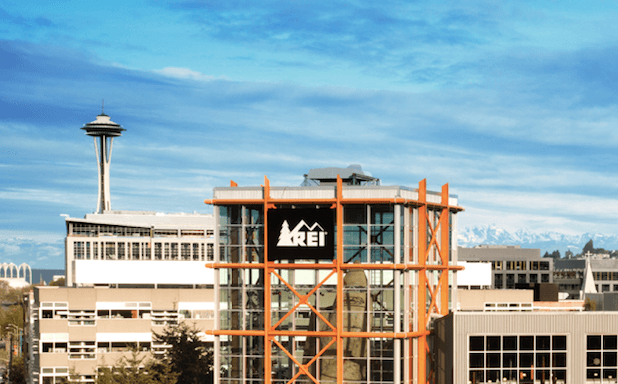
REI has long been a sustainability champion, from encouraging consumers to skip Black Friday, to its sponsorship of outdoor events, to the expansion of its popular “garage sales” of gently used or worn goods from solely its brick-and-mortar locations to online.
Yesterday, the popular outdoor apparel and gear retailer announced that it would roll out rigorous sustainability standards across its supply chain. The more than 1,000 brands that can be currently found on REI’s stores or its web site, insists the co-op, will “make it easier for millions of outdoor enthusiasts to choose more sustainable products.”
These new standards outline REI’s expectations for how apparel and gear manufacturers should adhere to the company’s desired level of environmental, social and animal welfare impacts – based upon what the company says it has done over the past several years with its own suite of branded products.
According to REI, these standards were shaped by feedback from dozens of partner brands, from small firms to global apparel giants, which together manufacture the varied product lines found in the company's stores. Years of participation with the Outdoor Industry Association Sustainability Working Group and other sustainability forums also were attributed to helping the company frame this 12-page document. The company claims these updated standards are feasible, focus on the most pressing environmental and social challenges and are reflective of the outdoor gear industry’s best practices.
Standards of which REI’s suppliers now need to be aware include fair trade certifications, the Leather Working Group, Forest Stewardship Council (FSC), and animal welfare guidelines including those that cover responsibly-sourced wool and down.
“We work with more than 1,000 brands, both large and small. Some, like prAna and Patagonia, are on the leading edge in integrating sustainability into their products and supply chains. Others may have a keen interest in sustainability but lack the resources to fully implement a program,” says Matthew Thurston, REI’s director of sustainability in a public statement. “We’re in a unique position to unite our brand partners around a common goal, by sharing best practices and resources that we’ve learned from both our own work and that of the brands we work with.”
Based on recent sales, REI is bullish that this accelerated commitment to sustainability can help the company perform strongly at all levels. The company also announced yesterday it reaped over $2.6 billion in sales during 2017, added 1 million more new members and that 70 percent of its profits went back into “community” – defined as the support of employees’ retirement programs, supporting outdoor-oriented nonprofits, work on outdoor trails for which the company funded - as well as the return of annual dividends to what is now as many as 17 million members who shop at its 151 stores across 36 U.S. states.
Image credit: REI
UPS-led Consortium Installs New EV Charging System

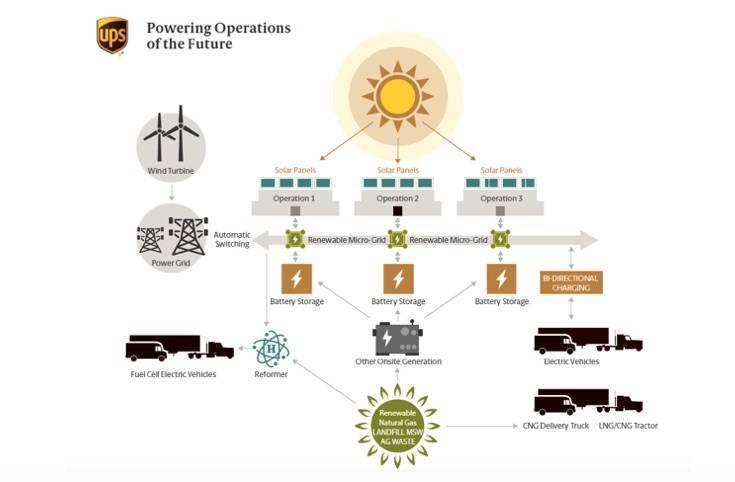
By Brian Collett
A new system allowing the recharging of a whole fleet of electrical vehicles without an upgrade to the power grid has been installed by a consortium led by UPS, the international logistics, carriage and delivery group.
The technology enables UPS to increase the number of vehicles at its central London site from 65 to 170, its entire fleet in the capital. The company says this marks the beginning of the end for reliance on combustion engine-powered vehicles.
The system embraces the use of second-life batteries, a conventional power upgrade, on-site storage, a smart grid, which involves smart meters and appliances and renewable, energy-efficient methods, and local power generation from solar and other alternative sources.
Peter Harris, UPS Europe’s sustainability director, said: “UPS thinks this is a world first, right in the heart of a mega-city.
“We are using new technology to work around some big obstacles to electric vehicle deployment, heralding a new generation of sustainable urban delivery services both here in London and in other major cities around the world.
“Electric vehicles are an integral component within UPS’s alternative fuel and advanced technology fleet.
“We are applying new technology to make the charging process smarter and our delivery service cleaner.”
UPS has developed the system with UK Power Networks Services, a sustainable energy company, and the Cross River Partnership, a public-private group set up to lead London regeneration projects.
Funding has come from the Office for Low Emission Vehicles, the UK government body encouraging the auto industry to manufacture environmentally acceptable products.
UPS first used electric vehicles in the 1930s and reintroduced them in 2001. Today it has more than 300 electric vehicles and nearly 700 hybrid versions in Europe and the US.
Tanja Dalle-Muenchmeyer, the Cross River Partnership’s electric freight program manager, said: “We need to find smarter solutions to electric vehicle charging if we want to benefit from the significant air quality and environmental benefits these vehicles offer, and we believe this is such a solution.”
Photo: UPS